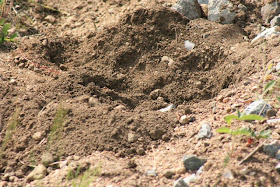 Yesterday I had posted about seeing a snapping turtle in the river, which I had titled Snapping Turtle in the river Part One.. Today's post, Part Two continues with my findings of a Snapping Turtle out of the river. Later on yesterday morning I had returned to the river area location and found a snapping turtle on the hillside. as shown below
Yesterday I had posted about seeing a snapping turtle in the river, which I had titled Snapping Turtle in the river Part One.. Today's post, Part Two continues with my findings of a Snapping Turtle out of the river. Later on yesterday morning I had returned to the river area location and found a snapping turtle on the hillside. as shown below Although I hadn't seen it laying its eggs I did find a place where the sandy soil had been disturbed and I presume likely this is where she ( the turtle had laid her eggs.) I will check this location in about three months time, on September 24th. to see if any baby turtle hatching is taking place. The incubation period is about three months depending upon the summer temperatures and weather conditions.
Although I hadn't seen it laying its eggs I did find a place where the sandy soil had been disturbed and I presume likely this is where she ( the turtle had laid her eggs.) I will check this location in about three months time, on September 24th. to see if any baby turtle hatching is taking place. The incubation period is about three months depending upon the summer temperatures and weather conditions. This turtle would have started her trek out in the river and would have had to climb up the embankment of the railroad track to reach this nest site location. The photo below of the old railroad bridge shows the river area and the challenging physicality of the area where the turtle would have had to travel.
This turtle would have started her trek out in the river and would have had to climb up the embankment of the railroad track to reach this nest site location. The photo below of the old railroad bridge shows the river area and the challenging physicality of the area where the turtle would have had to travel. The red arrow in the picture below indicates where the turtle nest was dug yesterday
The red arrow in the picture below indicates where the turtle nest was dug yesterday This pictures can perhaps help you appreciate the demanding terrain the turtle had to maneuver over to complete her egg laying task! When I found the turtle on the hillside she would have been on her way making her return trip to the river as she appears to be on a slight downhill incline..
This pictures can perhaps help you appreciate the demanding terrain the turtle had to maneuver over to complete her egg laying task! When I found the turtle on the hillside she would have been on her way making her return trip to the river as she appears to be on a slight downhill incline.. Bye, bye Ms. Turtle , we'll see you next in Part Three, happily relaxing in the river.
Bye, bye Ms. Turtle , we'll see you next in Part Three, happily relaxing in the river.Camera Critters is a meme where all sorts of critter photos are posted. If you are curious or would like to post your own photos like I have then please go to:http://camera-critters.blogspot.com/
Great capture of the snapping turtle.
ReplyDeleteReally interesting post. Boom & Gary of the Vermilon River, Canada.
ReplyDeleteSuch a great post Ann. please keep us posted. I'd love to see baby snappers.
ReplyDeleteB.
I had to go back to read part one... it truly is amazing what they put themselves (and their babies) through with their nesting habits.
ReplyDelete